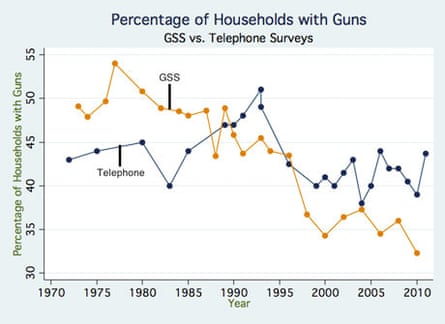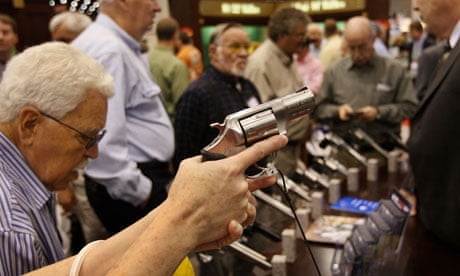The mass shooting in Aurora has brought the gun debate back to the foreground. There have been many enlightening articles on violent crime and gun ownership in America. One of the best posts belonged to NYU's Patrick Egan. He detailed the declining rates of violent crime and gun ownership, but I'd like to try and add to the points that Egan made.
1. We don't know the percentage of Americans who live in a house with a gun
We have to rely on polling data because there is no national database of who owns a gun. One poll is the the now biennial General Social Survey (GSS) conducted by the University of Chicago. These surveys are conducted face-to-face. We also traditional telephone polls conducted by ABC/Washington Post, CBS/New York Times, and Gallup.
The GSS found in the 2000s that an average 35% of Americans lived in a house with a gun in it, but that average was 7 percentage points higher in 23 telephone polls over the same period. This may not seem like a large difference, but it is, considering that we are dealing with 10,000+ interviews in the GSS surveys and 20,000+ interviews in the traditional telephone surveys. Why the gap?
The GSS gets about 70% of people to respond to its surveys, while traditional telephone poll response rates have fallen from about 30% in 2000 to about 10% today. Response rates for traditional telephone surveys tend to undercount blacks and Latinos. Africa -Americans and Latinos are also less likely than whites to own guns. Yet that may not have as much of an impact as you might think. We know that low response rates did not affect questions such as whether a person was a Democrat or a Republican.
You might be tempted to believe that people might answer more truthfully to a sensitive subject over the phone. People have not, however, changed their responses in GSS surveys since 2002, despite more anonymous methods being applied. Political science literature also indicates that people were actually less likely to be truthful over the phone than in person when it came to sensitive topics.
The truth is that there is no way to know whether 42%, 35%, or some other percentage of Americans are in a household with guns.
2. The percentage of Americans who are in a gun household hasn't dropped for 15 years and may be at 1970s levels

One of the most powerful figures in Egan's piece shows the decline of Americans living in a household with a gun since 1960. Let's concentrate only on the polls taken from the second half of 1996 and onward for a moment.
The GSS survey found from 1998 to 2004 that the percentage of Americans living in a household with a gun averaged 36%, while the percentage living in a house with a gun from 2004 to 2010 averaged 35%. There has been, in other words, no real movement. Compare that to the difference between the 1996 and 1998 GSS surveys when the percentage of gun households dropped from 44% to 37%.
The telephone surveys have similarly seen no movement in the past 15 years. An average of telephone polls from late 1996 through 2004 puts 41% of Americans living in a household with a gun. An average from 2004 to 2011 actually has a insignificantly higher 42% of Americans living in a household with a gun.
Furthermore, the percentage of people who live in gun houses according to telephone surveys over the past 15 years isn't actually any lower than it was from the mid-1970s to the mid-1980s. Over five Gallup telephone surveys from 1972 to 1985, the percentage of Americans in gun households averaged 43%. Over a similar 13-year stretch since 1999, the average percentage in telephone surveys is 41.5%. It was only between the mid-1980s to the mid-1990s that the percentage of gun households actually rose to a high of 51% before falling in the late 1990s.
3. The number of gun background checks is at a 14-year high
The FBI's National Instant Criminal Background Check System (NICS) has been background checking legal guns for since late 1998. Background checks are not perfectly lined up with the percentage of actual new guns. Some checks are being run on gun holders who are simply looking to upgrade their status to a concealed permit. Other gun owners may be purchasing more than one gun in a given transaction. Still, FBI spokesman Stephen Fischer has noted that new gun sales and NICS' checks are "correlated".

The number of background checks has gone up in every year since 2005, after being relatively stable from 1999 to 2005. In fact, there were about 2 million more guns checked in 2011 than in 2010. That could mean a number of things. First, more people are getting conceal permits. Second, more people who already have a gun are deciding to get another. Third, more people are getting guns than a few years ago. Fourth, more people are deciding to legalize their gun transactions instead of buying them on the black market.
My guess is that more people are getting concealed weapon permits and more people are buying more than one gun. Whatever the answer, this data suggests that there aren't less guns in the public sphere than before.
Conclusion: There are still many guns in America, and the rate is not dropping any more.
We don't know the exact percentage of gun households in America, but the number of guns per capita is higher than anywhere else in the world. The percentage of Americans who live in a household with a gun is probably near its lowest level in decades since the mid-1980s, but that rate has not dropped in the past 15 years.
